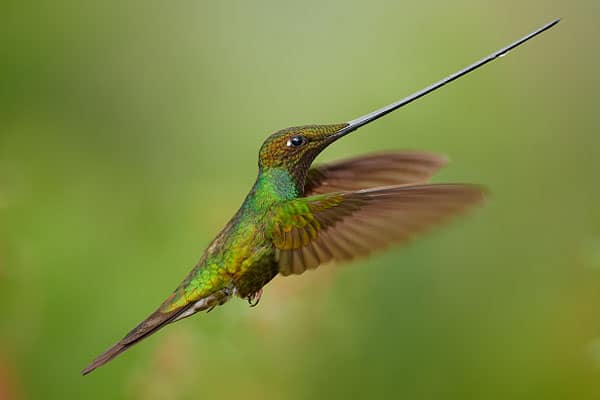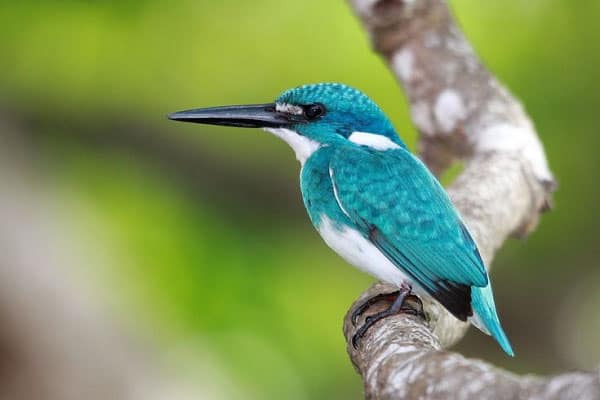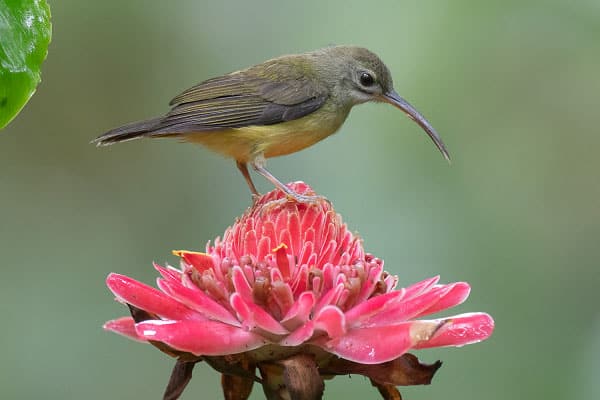Did you know that some small birds possess beaks that are longer than their own bodies? These remarkable avian creatures have evolved unique adaptations that allow them to thrive in their environments and access food sources that other birds cannot. In this article, we will delve into the beauty and grace of these small birds with long beaks, exploring their intriguing characteristics and the role they play in their ecosystems.
Main points to note:
- Small birds with long beaks have evolved unique adaptations to access food sources that other birds cannot.
- Species such as the Sword-Billed Hummingbird and Cerulean Kingfisher exhibit fascinating beak characteristics.
- These birds play important roles as pollinators and insectivores in their native habitats.
- Their vibrant plumage and graceful movements make them a delight to observe and study.
- Understanding the diverse adaptations of small birds with long beaks provides insights into the intricate web of life in the avian world.
Sword-Billed Hummingbird (Ensifera ensifera)
The sword-billed hummingbird, also known by its scientific name Ensifera ensifera, is a truly extraordinary species. What sets this hummingbird apart is its remarkable adaptation – an exceptionally long beak that is longer than its own body. This unique feature enables the sword-billed hummingbird to access nectar from tubular flowers that are inaccessible to other hummingbird species.
This impressive beak is believed to have evolved as a result of intense competition for food sources. By having an elongated beak, the sword-billed hummingbird can reach deep into the flowers to sip nectar, giving it a distinct advantage over its competitors. This adaptation allows the bird to feed on the abundant nectar within the flowers, ensuring its survival in its natural habitat.
“The sword-billed hummingbird’s beak is a fascinating example of nature’s incredible adaptations. It showcases the extraordinary lengths organisms will go to secure vital resources.”
While the sword-billed hummingbird’s beak may seem impractically long, it is actually quite efficient. The bird has a specialized tongue that can extend to match the length of its beak, further enabling it to access the nectar inside tubular flowers. This adaptation has allowed the species to carve out a unique ecological niche, exploiting a food source that is inaccessible to most other hummingbirds.

Found primarily in the Andean region of South America, the sword-billed hummingbird serves as an important pollinator. As it feeds on nectar, the bird inadvertently transfers pollen from flower to flower, facilitating the reproduction of various plant species.
Sword-Billed Hummingbird Facts
- The sword-billed hummingbird is the only bird species with a beak longer than its own body.
- It primarily feeds on nectar, but will also consume insects and spiders to supplement its diet.
- The wings of the sword-billed hummingbird beat at an incredibly rapid rate, allowing it to hover in mid-air with remarkable stability.
Despite its incredible beak and unique characteristics, the sword-billed hummingbird is facing numerous threats, primarily due to habitat loss and fragmentation. Conservation efforts are crucial to protect this remarkable species and ensure its survival for future generations to admire and appreciate.
| Physical Characteristics | Behavior |
|---|---|
| The sword-billed hummingbird has vibrant plumage, with shades of green and bronze. | This species is known for its territorial behavior, fiercely defending its feeding grounds. |
| The female sword-billed hummingbird is slightly larger than the male. | The sword-billed hummingbird has a high metabolism and must consume large amounts of nectar to sustain its energy levels. |
Cerulean Kingfisher (Alcedo coerulescens)
The cerulean kingfisher is a stunning avian species known for its vibrant blue plumage and long, slender beak. This small bird, scientifically referred to as Alcedo coerulescens, captivates observers with its striking appearance and remarkable hunting techniques.
With its sleek, streamlined body and sharply pointed beak, the cerulean kingfisher possesses the perfect tools for its hunting endeavors. This bird relies on its beak to catch small fish and insects, employing a swift and efficient hunting strategy.
Perched along the banks of rivers, streams, and other bodies of water, the cerulean kingfisher patiently awaits its prey. Once its keen eyes spot movement beneath the water’s surface, the bird swiftly dives in an instant, propelling itself underwater to secure its meal.
“The cerulean kingfisher showcases an impressive hunting technique, with its beak serving as a versatile tool for capturing small fish and insects,” says ornithologist Dr. Amelia Robinson.
Once the cerulean kingfisher captures its prey, it returns to the safety of its perch to consume its meal. This small bird’s beak is perfectly designed to grasp and secure its catch, ensuring that no morsel goes to waste.

Found in various regions across Asia, including Indonesia, Malaysia, and the Philippines, the cerulean kingfisher thrives in lush habitats with abundant water sources. These birds are often observed perched on overhanging branches or rocks, ready to dive into the water at a moment’s notice.
“The cerulean kingfisher’s precise hunting skills, coupled with its distinctive blue plumage, make it a sought-after sight for birdwatchers and wildlife enthusiasts alike,” adds Dr. Robinson.
The cerulean kingfisher, with its striking appearance and specialized beak, serves as a testament to the incredible diversity and adaptations found in the avian world. This small bird’s ability to navigate water ecosystems and secure its sustenance highlights the marvels of nature and the fascinating behavior of our feathered friends.
Slender-Billed Scimitar Babbler (Pomatorhinus superciliaris)
The Slender-Billed Scimitar Babbler, also known by its scientific name Pomatorhinus superciliaris, is a small bird that inhabits the dense forests of Southeast Asia. This exquisite avian species captivates bird enthusiasts and researchers alike with its distinctive long and curved beak.
The slender bill of the Scimitar Babbler serves as a valuable tool for its foraging activities. With its slender shape and curved tip, this beak enables the bird to explore the forest floor, probing into crevices, and vegetation in search of insects and small invertebrates. The remarkable adaptation of the Slender-Billed Scimitar Babbler’s beak allows it to access hidden food sources that other bird species might miss.
This small bird’s distinctive beak morphology provides it with a competitive advantage in its natural habitat. By utilizing its slender bill to navigate tight spaces, the Slender-Billed Scimitar Babbler can secure a diverse diet and thrive in its forest environment. Its foraging behavior plays a vital role in maintaining the delicate balance of the ecosystem it calls home.

Conservation Status and Threats
The Slender-Billed Scimitar Babbler is currently listed as Near Threatened on the International Union for Conservation of Nature (IUCN) Red List. Habitat loss, primarily due to deforestation and degradation, poses a significant threat to the population of this bird species. Additionally, the illegal wildlife trade also contributes to their declining numbers.
Efforts are being made to protect the Slender-Billed Scimitar Babbler and its habitat. Creating protected areas, promoting sustainable forestry practices, and raising awareness about the importance of conserving this unique bird species are crucial steps towards ensuring its long-term survival.
| Common Name | Scientific Name | Conservation Status |
|---|---|---|
| Slender-Billed Scimitar Babbler | Pomatorhinus superciliaris | Near Threatened |
| Sword-Billed Hummingbird | Ensifera ensifera | Vulnerable |
| Cerulean Kingfisher | Alcedo coerulescens | Least Concern |
Little Spiderhunter (Arachnothera longirostra)
One of the fascinating small birds with long beaks is the Little Spiderhunter. With its slender and elongated beak, the Little Spiderhunter showcases its remarkable adaptability in extracting sweet nectar from long tubular flowers. Its beak acts as a perfect tool for reaching deep into the blossoms and savoring the sugary reward.

In addition to its nectar-feeding abilities, the Little Spiderhunter is equipped to hunt spiders and insects, utilizing its beak to catch and consume its prey. This versatile little bird adeptly navigates between flower foraging and hunting, showcasing its resourcefulness and versatility in survival.
“The long, thin beak of the Little Spiderhunter is a testament to its impressive feeding adaptations.”
The Little Spiderhunter’s beak is a perfect example of nature’s ingenuity, allowing this small bird to thrive in its habitat. Its ability to sustain itself through both nectar and insects highlights its versatility as a forager.
The Unique Adaptations of the Little Spiderhunter:
- Long, thin beak for accessing nectar from tubular flowers
- Sharp beak tip for capturing and consuming spiders and insects
- Agile flight and maneuverability for efficient foraging
These unique adaptations make the Little Spiderhunter a fascinating subject for scientific study and a delightful sight for birdwatchers and nature enthusiasts alike.
Eastern Spinebill (Acanthorhynchus tenuirostris)
The eastern spinebill is a small bird native to Australia, known for its slender, downward-curved beak. This unique beak shape is perfectly adapted for sipping nectar from flowers, allowing the spinebill to play a crucial role as a pollinator in its native habitats.
With its long, delicate beak, these small eastern spinebill birds with long beaks can reach into the depths of tubular flowers, extracting the sweet nectar hidden inside. As it moves from flower to flower, the spinebill inadvertently spreads pollen, aiding in the fertilization and reproduction of various plant species. This mutualistic relationship between the spinebill and the flowers it feeds on is essential for maintaining biodiversity and ecosystem health.
In addition to its specialized beak, the eastern spinebill also features vibrant plumage. Its chestnut-colored body, contrasting with a black head, throat, and wings, makes for a visually striking sight in its natural habitat. This small bird is a joy to observe as it flits between flowers, its long beak serving as a delicate instrument in the intricate dance of pollination.
Conservation Status
The eastern spinebill is not currently classified as a threatened species. However, like many other native Australian birds, it faces various challenges, including habitat loss and fragmentation due to urbanization and land clearing. Conservation efforts focus on protecting and restoring its natural habitats, ensuring the survival of not only the eastern spinebill but also the entire ecological community it supports.
Eastern Spinebill Quick Facts
- Scientific name: Acanthorhynchus tenuirostris
- Size: Approximately 13-16 cm in length
- Habitat: Forests, woodlands, gardens, and heathlands
- Feeding habits: Nectar, insects, and spiders
- Distribution: Found along the eastern and southeastern coasts of Australia
| EASTERN SPINEBILL | DESCRIPTION |
|---|---|
| Size | Approximately 13-16 cm in length |
| Habitat | Forests, woodlands, gardens, and heathlands |
| Feeding Habits | Nectar, insects, and spiders |
| Distribution | Found along the eastern and southeastern coasts of Australia |
Mountain Velvetbreast (Lafresnaya lafresnayi)
The mountain velvetbreast, scientifically known as Lafresnaya lafresnayi, is an exquisite bird with a long, slightly curved beak that is perfectly adapted for feeding on the nectar of various flowering plants. This species is renowned for its vibrant coloration, which features a velvety blue-black head, shimmering green back, and a distinctive white patch on its throat.
Primarily found in the high-altitude cloud forests of South America, the mountain velvetbreast thrives in mountainous regions of Colombia, Venezuela, and Ecuador. Its preference for these elevated habitats has earned it the common name “mountain” velvetbreast.
With its unique beak, the mountain velvetbreast expertly navigates through floral landscapes, extracting nectar from tubular flowers. This remarkable feeding adaptation not only sustains the bird’s energy but also plays a crucial role in pollination, as they transfer pollen from flower to flower.
The mountain velvetbreast’s graceful presence and striking plumage make it a captivating sight for bird enthusiasts. Its ability to thrive in challenging high-altitude environments further highlights its resilience and adaptability. As we continue to explore the diverse avian world, the mountain velvetbreast stands out as another remarkable example of nature’s ingenuity and beauty.
Check Our Previous Articles:
Frequently Asked Questions
Q1: What is unique about small birds with long beaks?
Small birds with long beaks possess unique characteristics that make them fascinating to observe and study. Their long beaks enable them to access specific food sources, such as nectar from tubular flowers or insects hidden in crevices.
Q2: What makes the sword-billed hummingbird special?
The sword-billed hummingbird (Ensifera ensifera) is known for its exceptionally long beak, which is longer than its body. This adaptation allows it to feed on nectar from tubular flowers that other hummingbirds cannot access.
Q3: How does the cerulean kingfisher use its long beak?
The cerulean kingfisher (Alcedo coerulescens) uses its long, slender beak to catch small fish and insects by swiftly diving into the water from a perch.
Q4: How does the slender-billed scimitar babbler forage for food?
The slender-billed scimitar babbler (Pomatorhinus superciliaris) uses its long, curved beak to forage for insects and small invertebrates on the forest floor. Its slender bill allows it to probe into crevices and vegetation with ease.
Q5: What is the feeding behavior of the little spiderhunter?
The little spiderhunter (Arachnothera longirostra) uses its long, thin beak to extract nectar from flowers, especially those with long tubular shapes. It also feeds on spiders and insects, capturing them with its beak.
Q6: How does the eastern spinebill contribute to its native habitats?
The eastern spinebill (Acanthorhynchus tenuirostris) plays a crucial role as a pollinator due to its slender, downward-curved beak, which is perfectly designed for sipping nectar from flowers.


Add comment